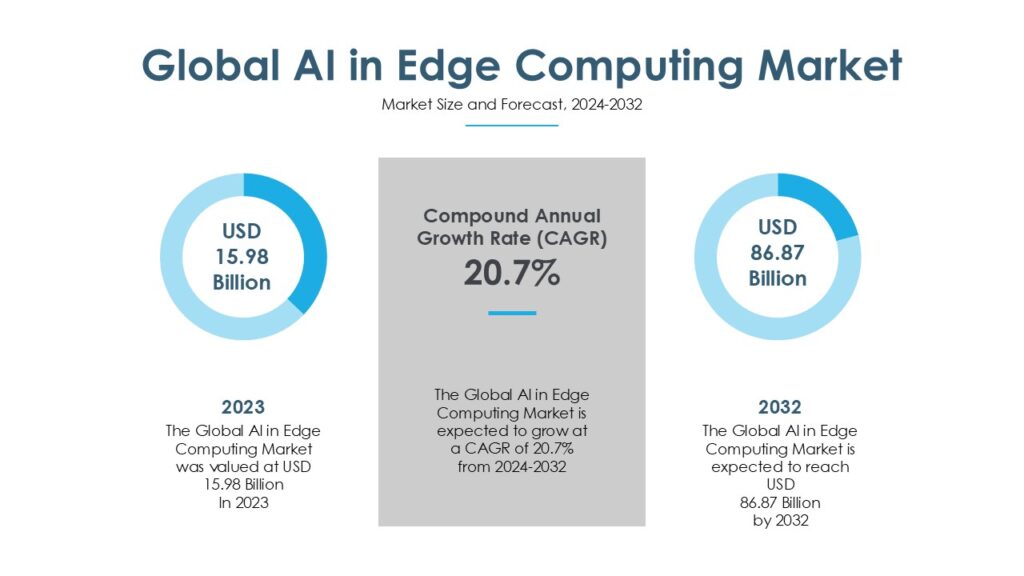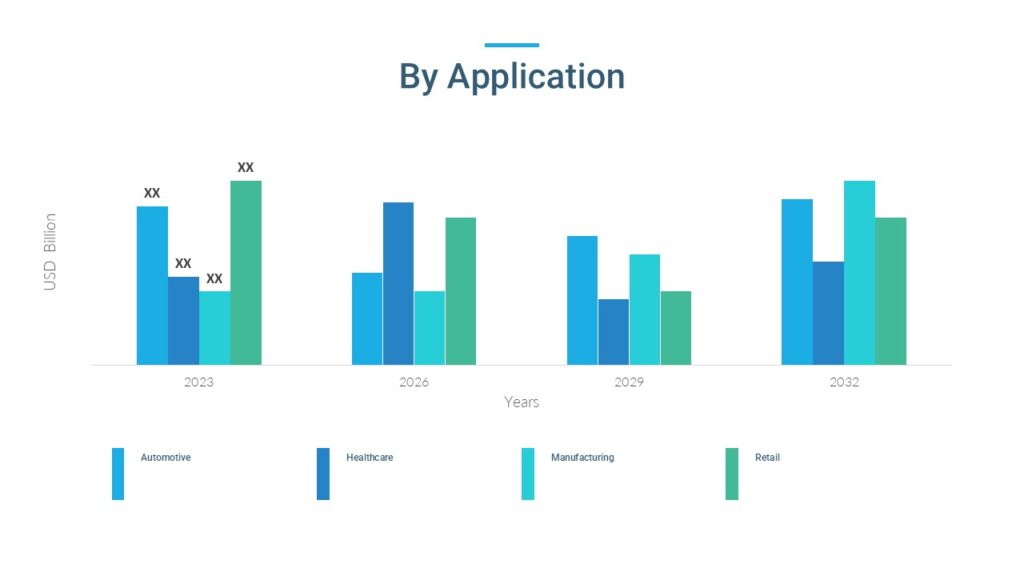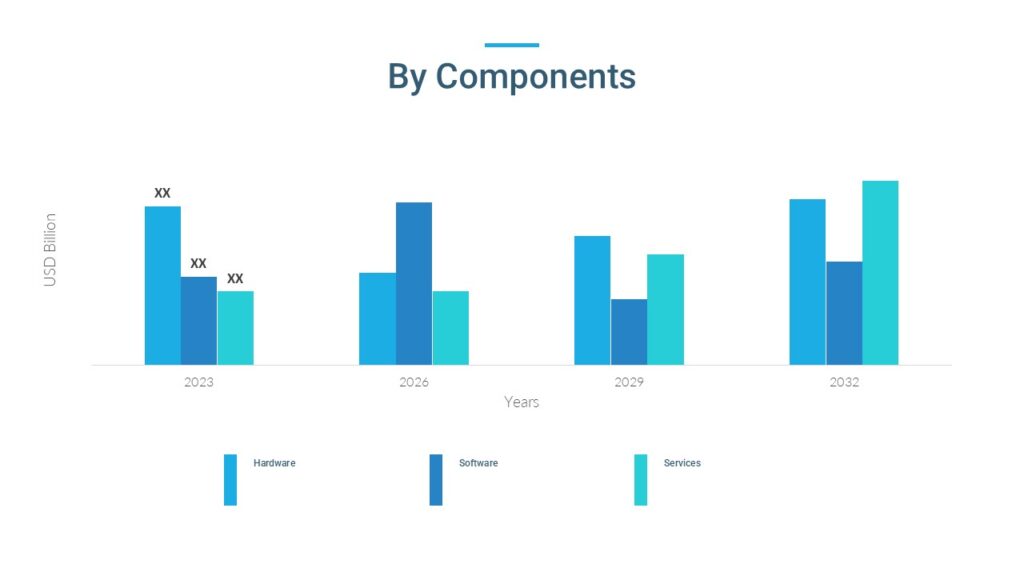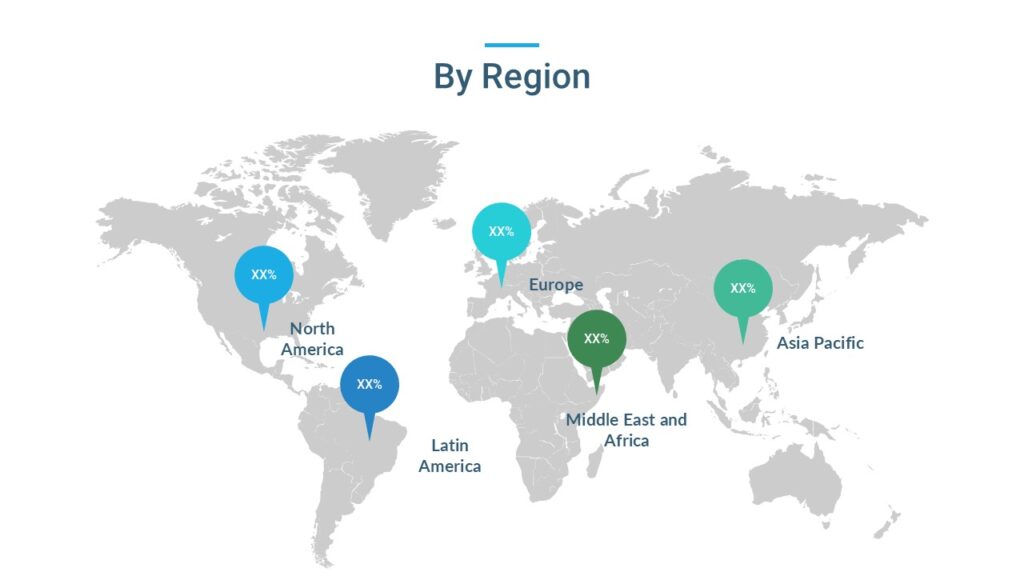
Global AI in Edge Computing Market "(By Components: Hardware, Software, Services; By Deployment Model: On-Premises, Cloud-Based, Hybrid; By End-Use Industry: Automotive, Healthcare, Manufacturing, Retail; By Region: North America, Europe, Asia Pacific, Latin America, and Middle East and Africa)”- Global Industry Analysis, Size, Share, Growth, Trends, And Forecast, 2024-2032
- Category: ICT, Automation and Semiconductor
- Report ID: CMR34091
- Published Date:
A prominent research firm, Cognizance Market Research added a cutting-edge industry report on the “Global AI in Edge Computing Market”. The report studies the current and past growth trends and opportunities for the market to gain valuable insights during the forecast period from 2023 to 2032.
Global AI in Edge Computing Market Analysis:
According to cognizance market research, the Global AI in Edge Computing Market was valued at US$ 15,260.68 Million in 2022 and is anticipated to reach US$ 30,645.05 Million by the end of 2032 with a CAGR of 10.68% from 2023 to 2032.

What is the Global AI in Edge Computing Market?
The global AI in edge computing market describes the incorporation of artificial intelligence-based solutions in the edge computing scenario for processing data at the periphery rather than over a centralized cloud service. This enables quicker decision-making, low latency, and optimized data handling with complex applications such as IoT, self-driving cars smart cities, and the like.
Edge computing with the help of artificial intelligence provides such advantages as the need to process a large amount of data without affecting a cloud; a better system’s performance; work security; and the lack of complete reliance on cloud services. Some of the important factors that define this market include Artificial Intelligence algorithms and Machine learning models; as well as system hardware including GPUs, FPGAs, and AI-focused chipsets.
This cloud is developing in the light of competition between the old generation chipset makers like NVIDIA, Intel, and Qualcomm along with the new and major cloud service providers like AWS, Microsoft, and Google Cloud. Which is experiencing the highest level of growth including investments in AI and IoT technologies in the Asia-Pacific region. North America and Europe are still key markets driven by the combinations of technology and integration of AI into different industries.
Global AI in Edge Computing Market Outlook:
Global AI in the edge computing market is expected to experience considerable growth in the future, which can be attributed to growing IoT devices, demand for raw real-time data analysis, and innovative AI technologies. Automotive, healthcare, manufacturing, etc., industries are now finding and implementing AI and edge computing to improve the productivity of roles and timely decision-making.
North America continues to hold the largest share of the market driven by the availability of technology giants, enhanced infrastructure, and early adoption by various industries of edge AI solutions. Europe comes next in line with a particular focus on industrial applications, automotive concepts, and smart and connected city initiatives. At the same time, the Asia-Pacific region is demonstrating high growth rates primarily in manufacturing, telecommunications, and consumer electronics as the governments of the countries of this region take active steps to popularize AI and IoT technologies.
Prominent market sectors that are NVIDIA, Intel, Qualcomm, Microsoft, Google Cloud, and more are continually innovative to revolutionize the market in terms of strategic partnerships. These companies are now targeting higher positioning through the creation of special chips, edge devices as well as integrated software to support various application kinds. Furthermore, AI-edge commitments with telecom providers and enterprises are injecting additional momentum into global AI-edge infrastructure.
It is also marked by the presence of more focused startups and new entrants who offer solutions exclusive to sectors or uses of, for example, Industrial IoT, autonomous systems, or healthcare monitoring. It is with these smaller players leveraging a skills gap and challenges that the market is now seeing innovative approaches being deployed as they partner with larger technological firms to spread their solutions throughout the range of industries.
Future, the market size of AI in edge computing is presumed to achieve a remarkable CAGR in the global market due to rising applications across industries and geographical sectors. The creation of a more advanced synergy between AI and edge computing technologies has the potential of extending to other application areas like agriculture, energy management, and defense.
Segment Analysis:

The industry is divided into component types, deployment modalities, the industries to which it is used, and the regions of the world. By component, the market is divided into hardware such as edge devices, AI Chips like GPU and FPGA, Software that consists of AI algorithms and analytics platforms, and services that include Managed services and system integration. The hardware segment accounts for the biggest market share due to developments in edge processors and AI-integrated devices, and the software and services segment is crucial to creating bespoke and easily scalable solutions.

Technologically, the most important areas for end-users are automotive, healthcare, manufacturing, and retailing where applications such as autonomous driving, V2X communication, remote health monitoring and diagnosing, predictive maintenance in smart factories, and surveillance for personalized shopping are included. Deployment types include onsite, offsite, and a combination of both, and the last of these has recently gained popularity due to the duality of the challenges involved in handling data. North America has adopted the biggest share of the market for technologies due to the absorption of digital technologies; Europe comes a close second, while Asia-Pacific is growing heavily as industries and consumers buy into smart technologies.

Geographical Analysis:
North America dominates the global AI in edge computing market due to advancements in technology, the presence of leading players including NVIDIA and Intel, and a rapidly growing operational AI in sectors including but not limited to, healthcare, automotive, and retail. The area’s emphasis on real-time and highly developed Internet of Things applications shall guarantee its longevity.
Europe is one of the major stakeholders especially in industrial automation, automotive, and smart city. Germany is one of the most advanced countries investing in AI and IoT because of its robust regulatory environment that fosters the industries with an increased degree of investment from France, and the United Kingdom. The region perceives efficiency and sustainability as crucial, and hence AI in edge computing is a crucial technology for the region’s economic and technological development.
Asia Pacific is the leading market that is growing rapidly with high usage in manufacturing, consumer electronics, telecommunication industries, etc. China, Japan, and South Korea outperform others stimulated by government and industrial promotion. South America and Africa are now promising regions, that invest more in AI and edge computing, especially in agriculture, energy, and safety segments because they are looking for solutions for local issues with new technologies.

The report offers the revenue of the Global AI in Edge Computing Market for the period 2020-2032, considering 2020 to 2022 as a historical year, 2023 as the base year, and 2024 to 2032 as the forecast year. The report also provides the compound annual growth rate (CAGR) for the Global AI in Edge Computing Market for the forecast period. The Global AI in Edge Computing Market report provides insights and in-depth analysis into developments impacting enterprises and businesses on a regional and global level. The report covers the Global AI in Edge Computing Market performance in terms of revenue contribution from several segments and comprises a detailed analysis of key drivers, trends, restraints, and opportunities prompting revenue growth of the Global AI in Edge Computing Market.
The report has been prepared after wide-ranging secondary and primary research. Secondary research included internet sources, numerical data from government organizations, trade associations, and websites. Analysts have also employed an amalgamation of bottom-up and top-down approaches to study numerous phenomena in the Global AI in Edge Computing Market. Secondary research involved a detailed analysis of significant players’ product portfolios. Literature reviews, press releases, annual reports, white papers, and relevant documents have been also studied to understand the Global AI in the Edge Computing Market. Primary research involved a great extent of research efforts, wherein experts carried out interviews telephonic as well as questioner-based with industry experts and opinion-makers.
The report includes an executive summary, along with a growth pattern of different segments included in the scope of the study. The Y-o-Y analysis with elaborate market insights has been provided in the report to comprehend the Y-o-Y trends in the Global AI in Edge Computing Market. Additionally, the report focuses on altering competitive dynamics in the global market. These indices serve as valued tools for present market players as well as for companies interested in participating in the Global AI in Edge Computing Market. The subsequent section of the Global AI in Edge Computing Market report highlights the USPs, which include key industry events (product launch, research partnership, acquisition, etc.), technology advancements, pipeline analysis, prevalence data, and regulatory scenarios.
Global AI in Edge Computing Market Competitive Landscape:
There are several small and major firms participating in the highly fragmented Global AI in Edge Computing Market. The new strategies formed by companies revolve around accuracy and precision. The following are some of the major market participants:
- NVIDIA
- Intel Corporation
- Microsoft
- IBM
- Qualcomm Technologies Inc.
- Amazon Web Service
- Cisco System
- HPE
- Arm Holdings
The report explores the competitive scenario of the Global AI in Edge Computing Market. Major players working in the Global AI in Edge Computing Market have been named and profiled for unique commercial attributes. Company overview (company description, product portfolio, geographic presence, employee strength, Key management, etc.), financials, SWOT analysis, recent developments, and key strategies are some of the features of companies profiled in the Global AI in Edge Computing Market report.
Segmentation:
Global AI in Edge Computing Market, By Component:
- Hardware
- Software
- Services
Global AI in Edge Computing Market, By Deployment:
- On-Premises
- On-Cloud
- Hybrid
Global AI in Edge Computing Market, By End-use Industry:
- Automotive
- Healthcare
- Manufacturing
- Retail
Global AI in Edge Computing Market, by Region:
- North America
- U.S.
- Canada
- Europe
- Germany
- U.K.
- France
- Spain
- Italy
- Rest of Europe
- Asia Pacific
- Japan
- China
- India
- Australia & New Zealand
- South Korea
- Rest of Asia Pacific
- Latin America
- Brazil
- Mexico
- Rest of Latin America
- Middle East & Africa
- GCC
- South Africa
- Rest of the Middle East & Africa
Research Methodology: Aspects
Market research is a crucial tool for organizations aiming to navigate the dynamic landscape of customer preferences, business trends, and competitive landscapes. At Cognizance Market Research, acknowledging the importance of robust research methodologies is vital to delivering actionable insights to our clientele. The significance of such methodologies lies in their capability to offer clarity in complexity, guiding strategic management with realistic evidence rather than speculation. Our clientele seek insights that excel superficial observations, reaching deep into the details of consumer behaviours, market dynamics, and evolving opportunities. These insights serve as the basis upon which businesses craft tailored approaches, optimize product offerings, and gain a competitive edge in an ever-growing marketplace.
The frequency of information updates is a cornerstone of our commitment to providing timely, relevant, and accurate insights. Cognizance Market Research adheres to a rigorous schedule of data collection, analysis, and distribution to ensure that our reports reflect the most current market realities. This proactive approach enables our clients to stay ahead of the curve, capitalize on emerging trends, and mitigate risks associated with outdated information.
Our research process is characterized by meticulous attention to detail and methodological rigor. It begins with a comprehensive understanding of client objectives, industry dynamics, and research scope. Leveraging a combination of primary and secondary research methodologies, we gather data from diverse sources including surveys, interviews, industry reports, and proprietary databases. Rigorous data analysis techniques are then employed to derive meaningful insights, identify patterns, and uncover actionable recommendations. Throughout the process, we remain vigilant in upholding the highest standards of data integrity, ensuring that our findings are robust, reliable, and actionable.
Key phases involved in in our research process are mentioned below:

Understanding Clients’ Objectives:
Extensive Discussions and Consultations:
- We initiate in-depth discussions and consultations with our clients to gain a comprehensive understanding of their objectives. This involves actively listening to their needs, concerns, and aspirations regarding the research project.
- Through these interactions, we aim to uncover the underlying motivations driving their research requirements and the specific outcomes they hope to achieve.
Industry and Market Segment Analysis:
- We invest time and effort in comprehensively understanding our clients’ industry and market segment. This involves conducting thorough research into market trends, competitive dynamics, regulatory frameworks, and emerging opportunities or threats.
- By acquiring a deep understanding of the broader industry landscape, we can provide context-rich insights that resonate with our clients’ strategic objectives.
Target Audience Understanding:
- We analyze our clients’ target audience demographics, behaviors, preferences, and needs to align our research efforts with their consumer-centric objectives. This entails segmenting the audience based on various criteria such as age, gender, income level, geographic location, and psychographic factors.
- By understanding the nuances of the target audience, we can tailor our research methodologies to gather relevant data that illuminates consumer perceptions, attitudes, and purchase intent.

Identifying Challenges and Opportunities:
- We proactively identify the challenges and opportunities facing our clients within their respective industries. This involves conducting SWOT (Strengths, Weaknesses, Opportunities, Threats) analyses and competitive benchmarking exercises.
- By identifying potential obstacles and growth drivers, we can provide strategic recommendations that help our clients navigate complexities and capitalize on emerging opportunities effectively.
Grasping Specific Goals:
- We delve into the intricacies of our clients’ objectives to gain clarity on the specific goals they aim to accomplish through the research. This entails understanding their desired outcomes, such as market expansion, product development, or competitive analysis.
- By gaining a nuanced understanding of our clients’ goals, we can tailor our research approach to address their unique challenges and opportunities effectively.
Data Collection:

Primary Research Process:
- Surveys: We design and administer surveys tailored to capture specific information relevant to our clients’ objectives. This may involve employing various survey methodologies, such as online, telephone, or face-to-face interviews, to reach target audiences effectively.
- Interviews: We conduct structured or semi-structured interviews with key stakeholders, industry experts, or target consumers to gather in-depth insights and perspectives on relevant topics. These interviews allow us to probe deeper into specific issues and uncover valuable qualitative data.
- Focus Groups: We organize focus group discussions with carefully selected participants to facilitate interactive discussions and gather collective opinions, attitudes, and preferences. This qualitative research method provides rich contextual insights into consumer behaviors and perceptions.
- Observations: We conduct observational research by directly observing consumer behaviors, interactions, and experiences in real-world settings. This method enables us to gather objective data on consumer actions and reactions without relying on self-reported information.
Secondary Research Process:
- Literature Review: We conduct comprehensive literature reviews to identify existing studies, academic articles, and industry reports relevant to the research topic. This helps us gain insights into previous research findings, theoretical frameworks, and best practices.
- Industry Reports: We analyze industry reports published by reputable trade associations (whitepapers, research studies, etc.), and government agencies (U.S. Census Bureau, Bureau of Labor Statistics, and Securities and Exchange Commission etc.) to obtain macro-level insights into market trends, competitive landscapes, and industry dynamics.
- Government Publications: We review government publications, such as economic reports, regulatory documents, and statistical databases, to gather relevant data on demographics, market size, consumer spending patterns, and regulatory frameworks.
- Online Databases: We leverage online databases, such as industry portals, and academic repositories (PubMed Central (PMC), ScienceDirect, SSRN (Social Science Research Network), Directory of Open Access Journals (DOAJ), NCBI, etc.), to access a wide range of secondary data sources, including market statistics, financial data, and industry analyses.


Data Analysis:
The data analysis phase serves as a critical juncture where raw data is transformed into actionable insights that inform strategic decision-making. Through the utilization of analytical methods such as statistical analysis and qualitative techniques like thematic coding, we uncover patterns, correlations, and trends within the data. By ensuring the integrity and validity of our findings, we strive to provide clients with accurate and reliable insights that accurately reflect the realities of the market landscape.

Transformation of Raw Data:
- Upon collecting the necessary data, we transition into the data analysis phase, where raw data is processed and transformed into actionable insights. This involves organizing, cleaning, and structuring the data to prepare it for analysis.
Utilization of Analytical Methods:
- Depending on the research objectives, we employ a diverse range of analytical methods to extract meaningful insights from the data. These methods include statistical analysis, trend analysis, regression analysis, and qualitative coding.
Statistical Analysis:
- Statistical tools are instrumental in uncovering patterns, correlations, and trends within the data. By applying statistical techniques such as descriptive statistics, hypothesis testing, and multivariate analysis, we can discern relationships and derive valuable insights.
Qualitative Analysis Techniques:
- In addition to quantitative analysis, we leverage qualitative analysis techniques to gain deeper insights from qualitative data sources such as interviews or open-ended survey responses. One such technique is thematic coding, which involves systematically categorizing and interpreting themes or patterns within qualitative data.
Integrity and Validity Maintenance:
- Throughout the analysis process, we maintain a steadfast commitment to upholding the integrity and validity of our findings. This entails rigorous adherence to established methodologies, transparency in data handling, and thorough validation of analytical outcomes.
Data Validation:
The final phase of our research methodology is data validation, which is essential for ensuring the reliability and credibility of our findings. Validation involves scrutinizing the collected data to identify any inconsistencies, errors, or biases that may have crept in during the research process. We employ various validation techniques, including cross-referencing data from multiple sources, conducting validity checks on survey instruments, and seeking feedback from independent experts or peer reviewers. Additionally, we leverage internal quality assurance protocols to verify the accuracy and integrity of our analysis. By subjecting our findings to rigorous validation procedures, we instill confidence in our clients that the insights they receive are robust, reliable, and trustworthy.

Importance of Data Validation:
- Data validation is the final phase of the research methodology, crucial for ensuring the reliability and credibility of the findings. It involves a systematic process of reviewing and verifying the collected data to detect any inconsistencies, errors, or biases.
Scrutiny of Collected Data:
- The validation process begins with a thorough scrutiny of the collected data to identify any discrepancies or anomalies. This entails comparing data points, checking for outliers, and verifying the accuracy of data entries against the original sources.
Validation Techniques:
- Various validation techniques are employed to ensure the accuracy and integrity of the data. These include cross-referencing data from multiple sources to corroborate findings, conducting validity checks on survey instruments to assess the reliability of responses, and seeking feedback from independent experts or peer reviewers to validate the interpretation of results.
Internal Quality Assurance Protocols:
- In addition to external validation measures, internal quality assurance protocols are implemented to further validate the accuracy of the analysis. This may involve conducting internal audits, peer reviews, or data validation checks to ensure that the research process adheres to established standards and guidelines.
Report Scope:
Attribute
Description
Market Size
US$ 86.87 Billion (2032)
Compound Annual Growth Rate (CAGR)
20.7%
Base Year
2023
Forecast Period
2024-2032
Forecast Units
Value (US$ Billion)
Report Coverage
Revenue Forecast, Competitive Landscape, Growth Factors, and Trends
Geographies Covered
North America, Europe, Asia Pacific, Latin America, Middle East & Africa
Countries Covered
U.S., Canada, Germany, U.K., France, Spain, Italy, Rest of Europe, Japan, China, India, Australia & New Zealand, South Korea, Rest of Asia Pacific, Brazil, Mexico, Rest of Latin America, GCC, South Africa, Rest of Middle East & Africa
Key Companies Profiled
NVIDIA, Intel Corporation, Microsoft, IBM, Qualcomm Technologies Inc., Google, Amazon Web Service, Cisco System, HPE, and Arm Holdings
Key Questions Answered in AI in Edge Computing Market Report
How big was the Global AI in Edge Computing Market in 2023?
It was Valued at US$ 15.98 Billion in 2023.
How big will be the industry size in 2032?
It is projected to reach more than US$ 86.87 Billion by 2032.
What will be the CAGR during the forecast period?
It is anticipated to be 20.7% from 2024 to 2032.
What are the trends, drivers, opportunities, and challenges in the Global AI in Edge Computing Market?
Trend: Rising use of AI as an interface between IoT and another network for real-time analysis of data at the edge.
Driver: Growing importance of minimizing the response time required by the system involved from the application level, such as self-driving cars and industry 4.0.
Opportunities: An evolving business application of this current decade on edge AI to incorporate advanced sectors such as agriculture, energy, and defense to create smarter systems.
Challenges: The cost of AI systems is relatively high in the early stages of deployment and decentralization or bringing AI to the edges of a network poses a challenge.
What are the major players operating in the Global AI in Edge Computing Market?
NVIDIA, Intel Corporation, Microsoft, IBM, Qualcomm Technologies Inc., Google, Amazon Web Service, Cisco System, HPE, and Arm Holdings.
We can customize every report – free of charge – including purchasing stand-alone sections or country-level reports
We help clients to procure the report or sections of the report at their budgeted price. Kindly click on the below to avail



